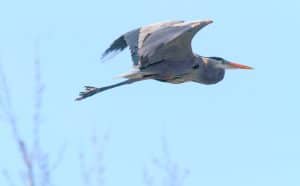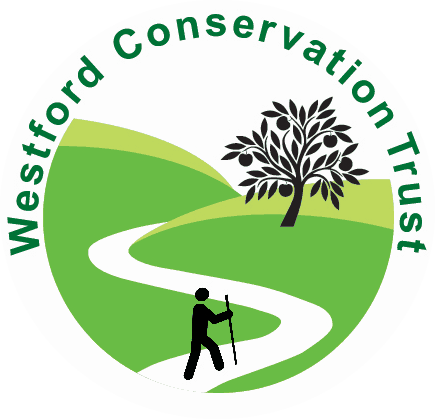
Happy New Year! Before going forward into the new year, I like to look back on the most notable wildlife sightings of the past year, so here goes:
The year was notable for climate change: generally warmer and wetter, which is what has been predicted for the northeast. In fact, 2023 was the warmest year ever recorded on Earth.
In January, a young, great blue heron was seen standing on a front lawn in the rain—perhaps trying to catch a chipmunk. The month had been warmer than usual, so these birds did not migrate to the coast until later in the winter. One of the joys of January is hearing the first spring songs of some of our resident birds: the “hear, hear” of the tufted titmouse, and the “hey sweetie” call of the black-capped chickadee. At the same time, a golden-crowned kinglet was heard, along with other winter birds like American tree sparrow, beautiful reddish fox sparrows and red-breasted nuthatches. Bluebirds were seen at several feeders in Westford. Four river otters were reported eating a fish on the ice on Mill Pond In Graniteville.
In February, the weather turned cold, then warm, then cold again. On Feb. 4, the thermometer showed four degrees below zero. By mid-month the temperature was up to the mid-50’s, and by the month’s end was back to the teens. The grackles arrived on time mid-February. Two pairs of hooded mergansers were seen on Grassy Pond. Fox sparrow and white-throated sparrow were at the feeder. On February 18 sixty-six common mergansers were feeding on Forge Pond— on migration, for sure. Red-breasted nuthatches were reported from most feeders. This bird is an occasional winter visitor here, last recorded five years ago.
In March, temperatures mostly stayed in the 30’s, with a snow storm. Despite the snow, a song sparrow was heard, and a pair of wood ducks flew overhead. On March 9, a pair of woodcocks were seen and heard displaying on Almeria Drive. By March 24, a large flock of dark-eyed juncos moved into the area. This same day, wood frogs and spring peepers were heard calling from wetlands. Spring had arrived! Other migrating ducks seen resting on Keyes Pond were goldeneye, Eurasian wigeons, and ring-necked ducks. Great blue herons also arrived at nesting sites. A black bear was out of hibernation and took down a feeder.
In April, my favorite birding month (good visibility because no new leaves, no mosquitoes or black flies) saw the return of many species of warbler: pine, palm, and yellow, and other migrants, ruby-crowned kinglets, and chipping sparrows. On April 11, the phoebes arrived. Climate change reminded us again of global warming when on April 13, the temperature shot up to 85 degrees! Juncos were last reported on April 21; they headed north for breeding. Shadbush, one of our earliest blooming shrubs, was showing its lovely white flowers along pond and river edges on April 24. Skunk cabbage was poking up in the wetlands. Red-winged blackbirds were on territory by this time, weaving nests among the reeds and cattails in rivers. A Baltimore oriole was first heard on April 25, two weeks earlier than usual. A red-shouldered hawk was heard along Gould Rd.
On May 2, the first ruby-throated hummingbird arrived ahead of schedule. By May 3, several bird watchers reported early Baltimore orioles. Other spring migrants arrived too: swamp sparrow, great-crested flycatcher, northern waterthrush, wood thrush, scarlet tanager, American redstart, rose-breasted grosbeak, Eastern wood-peewee, veery, warbling vireos, hermit thrush and cedar waxwings. American toads started singing at night on May 7th. Homeowners were disappointed that the forsythias did not bloom well, nor did azaleas. This was probably caused by a combination of the ongoing drought and the cold snap in February. Very few butterflies were reported: a few tiger swallowtails and a sulphur. Most butterfly species are declining rapidly, due to habitat loss and pesticide use. Many residents decided to participate in “No Mow May” in order to make their lawns more wildlife friendly. They were so pleased with the wildlife that they hosted, that some residents extended the “no mow” period for a few more months.
In June, a rare yellow-throated vireo was heard near Snake Meadow Brook. On June 7, an air quality alert was announced due to smoke from Canadian wildfires. The hazy, smoky air hung over us much of the month. On June 14, a rare bobolink pair was reported from Lakeside Meadows.
July was very hot—in the 90’s most of the month. The days of July 3-5 were announced as the hottest days ever recorded on earth, and in fact, the entire month of July was said to have been the hottest month ever recorded on earth. On July 7, the first lightning bugs were seen on Old Colony Drive. They appeared along the weedy edge between lawn and wood. Some residents decided not to mow a portion of their yards this summer, and found that they were hosting many fireflies and butterflies for the first time.
In August, hawks started their migration south flying in “kettles” to catch warm updrafts of air to speed them on their way. A bear was reported from Providence Rd, and a bobcat was seen at Stoneridge Rd.
September saw the continuation of migration, with ruby-throated hummingbirds leaving by September 11, for their long flight across the Gulf of Mexico and on to Central and South America. Many other migrants, such as blackbirds, warblers, phoebes and orioles were on their way south too. A spotted turtle was seen on Providence Rd.
October was generally not a good month for color this year—perhaps because of the lack of rain and warm temperatures at night. Late migrants, such as wood ducks, mergansers and, hermit thrushes were seen mid to late October. Some “spring peepers” were still singing in the marshes. Some low bush blueberries and lilacs were blooming a second time, presumably because of the warm weather. Kids went out in shirtsleeves on Halloween.
In November, the weather turned colder intermittently. An adult bald eagle was perched in a tree on Hildreth St. on November 2. Also on November 2 we had our first frost, but by November 3, the temperatures were up in the 50’s again. Skunk cabbage flowers poked their heads out of the marsh on November 6. On November 21, temps were again in the 30’s, and we had a dusting of snow on the ground. The first juncos arrived for their winter vacation. A bobcat family (mom and several young) was photographed on Almeria Drive.
In December, temperatures continued trending high—most days were in the 40’s or 50’s. mean temperature for the month was 44 degrees. December’s mean temperature was 12 degrees above normal for the month. We also got lots of rain, 6 inches, two inches above normal for the month. December 6, a light snow was falling, and on December 7 the temperature was 21 degrees, the coldest day yet. But by December 10, temps were again back up to the 50’s, and we experienced a big rain and wind storm. Birds flocked to feeders which helped them to make it through the storm. On December 18, another heavy wind and rain storm arrived, with 60 degree temperatures. On December 19, a great blue heron was seen flying over Rt. 110 (a winter holdover?) Winter sparrows, American tree sparrows and white-throated sparrows arrived at feeders. By December 30, house finches, chickadees and titmice were all singing their spring songs.
It appears that climate change has hit us in a big way this year. We must do all we can not to add to the problem. Look at Westford Climate Action website (westfordclimateaction.org) and click on the “take action” tab for ideas on personal changes you can make to help the climate and our precious wildlife. When worries beset us, the best solace is to get out into nature. Watch the birds and the plants as you walk, or just sit on a log or rock in the woods. It will pick up your mood and clear your mind.
December Reports
Marian/Bill Harman, Old Colony Drive. December 3, 42 degrees, raining. At the feeders: three chickadees, two titmice, one downy woodpecker, three juncos, one Carolina wren. December 4, 40 degrees, cloudy. One brown creeper in the woods. At the feeders: three mourning doves, five blue jays, one titmouse, one chickadee, one downy woodpecker, three gray squirrels. Dec. 6, 32 degrees, light snow falling. December 7, 21 degrees- coldest day yet. Earliest sunset of the year today. December 9, a skim of ice on the pond and swamp. December 10, 50 degrees, foggy, big rain and wind storm tonight. At the feeders: red-bellied woodpecker, male. Large female downy woodpecker, fourteen mourning doves (most yet), six blue jays, one chickadee, one titmouse, one white-breasted nuthatch. December 11, 40 degrees, rainy and windy. At the feeders: two titmice, three blue jays, one mourning dove, three downy woodpeckers (one male and two female), four goldfinches. December 18, 60 degrees! Heavy rain and wind. December 19, sunny, 42 degrees. At feeders: one junco, two blue jays, two chickadees, two downy woodpeckers, a pair of house finches, one white-breasted nuthatch, two goldfinches. December 20, sunny, 40’s. One red-bellied woodpecker, female, three goldfinches, one white-breasted nuthatch, two chickadees. December 27, 40’s, foggy. A new winter bird has arrived: American tree sparrow. December 29, rainy, 42 degrees. A big day at the feeders: Six mourning doves, one dark-eyed junco, three chickadees, five titmice, two downy woodpeckers, three cardinals (one male and two females). First bluebirds arrived at the feeder: two male and one female). One white-breasted nuthatch, one red-bellied woodpecker, three blue jays.
December 30, 42 degrees, rainy. A walk to the beaver dam: heard the house finches singing their spring song (with the “zip”), three male mallards swimming on Snake Meadow Brook.
Diane Duane, at Rt. 110. December 19, “Just saw a great blue heron flying over the Westford Valley Marketplace!”
Marian Harman is a member of the Westford Conservation Trust, a non-profit conservation organization, whose purpose is the preservation of Westford’s open spaces and trails. The Trust welcomes new members and volunteers. Check out our website at westfordconservationtrust.org and visit us on Facebook.
